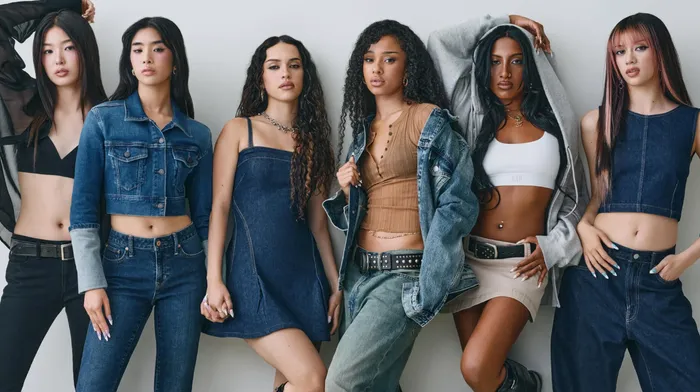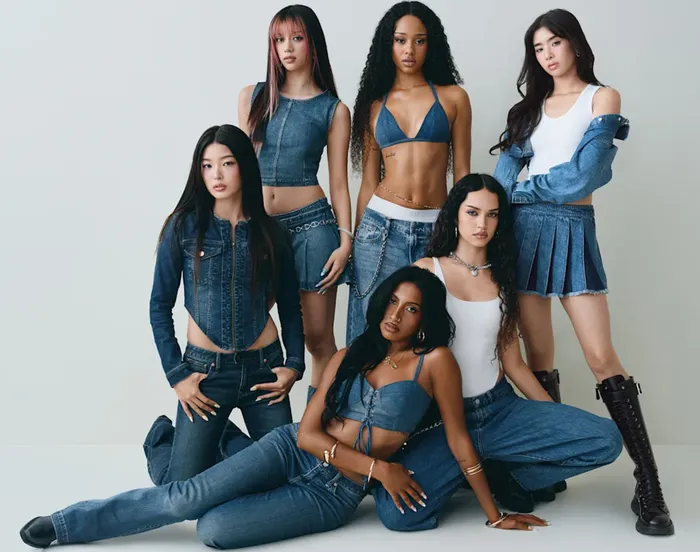
.
Image: GAP
Imagine you have an iPod mini, preferably metallic pink. You toggle to the song “Milkshake” by Kelis, there in black pixelated font. You plug in your wired headphones, and without any notifications to distract you, you click play. About twenty years before a little espresso fueled an addictively candy-coated cultural renaissance of feminine braggadocio, Kelis brought the boys to the yard in super low-rise jeans. (Bossy.)
Now, Gap is bringing both back.
The casual clothing brand is today relaunching its early 2000s “long and lean” denim style, which was first available between 2001 and 2010, for $89.95. This time around, the style comes in ten new washes and a few smart design updates for better wearability, along with a campaign featuring girl group Katseye performing “Milkshake.” Brace yourself, the “long and lean” is low-rise. And Gap’s not stopping there: it’s also releasing existing denim fits like its super baggy and 90’s straight in low-rise versions as well.
If mass market American brand Gap is going all in on low-rise this fall, that’s a major signal the cut is back in full force.
Low-rise denim has been making its comeback for a little while now, especially by fashion’s early adopters. Search interest in low rise jeans officially surpassed high rise jeans over a year ago, in May 2024, and this month search interest in the navel-baring style has reached an all-time high, according to Google Trends’ August report. Other clothing that’s searched at an all-time high this August? “Polo shirt,” “babydoll top,” and “baby tee.” Holy Abercrombie! “Vintage hollister” and “hollister 2000s,” referring to the olfactory-forward mall brand, were also top search terms, and considering the broader, rolling return of Y2K styles and brands over the past few years (camis, trucker hats, bedazzled sweatsuits and jeans, rimless sunglasses, etc.,) it was only a matter of time between corresponding denim styles returned to consumer shopping carts.
Gap’s own internal data proved out increasingly positive consumer sentiment for low rise jeans. The design team clocked low rise’s return to street style—a place they often look to for emerging trends—over the past couple of years and put feelers out with their customer. But they were too early. Until now. “We’ve been kind of waiting for this moment,” says senior vice president and general manager of Gap Specialty Noelle Rogers. “We tested a few times on low rise and it wasn’t until the last nine, ten months that the customer was ready.” Then they scaled.
“We always say, ‘we’re trend but not too trend,” adds Pattinson. “But there is this new customer that is very trend aware. Gen Z is so into everything.” And so Gap’s contemporary low rise portfolio makes a play for the large, existing customer base who used to buy the style, as well as Gen Z first-timers. Putting a style online early, even if its customer isn’t ready, allows the company to move fast once a trend goes big.
Now that low rise is taking off broadly, Gap is ensuring that millennials—those in their teens or 20s the first time this trend came around—will be comfortable wearing the midriff-challenging design again. Gap is making design changes to the waistband and pant legs that make low rise more approachable. “From the 2000s, it was all about this one fit,” says Pattinson. “Now, you have this big story which is low rise, but many fits within that, because we need that inclusivity and diversity. That’s the big, big difference of where we were in the 2000s. It’s a change. Still the same voice, but just speaking to it differently.”
The company ran a smaller batch of the “long and lean” style online last fall to test how it’d perform, and based off of a high volume of sales from that period, decided to go all in, increasing the style’s production and range to meet projected customer demand. “There’s a real appetite for this new proportion,” says Gap senior vice president and global head of design Jane Pattinson. When I met with her, she paired her Gap barrel jeans with a strappy Celine heeled sandal. “Sky high and high rise and mid-rise are still important; it’s just something new.”

.
Image: Gap
The Long and Lean style was a huge part of early 2000s Gap, worn by celebrities like Salma Hayek, Alanis Morissette, and Sarah Jessica Parker, and is a main character of many of its campaigns from the period, along with the Gap tag, “for every generation.”
In the Gap archives, near racks of vintage colorblocked windbreakers, corduroy caps, and a pull of vintage “long and lean” denim, Pattinson explains that while the archive is a treasure trove of inspiration, for now, this generation’s long and lean (and low-rise denim overall) is not the 2.5” zipper lowrise of yesteryear. Indeed, the long and lean hits about an inch below the navel, closer to a midrise style than Christina Aguilera-at-the-2001-VMA-award’s or Keira-Knightley-and-Jamie-Dornan-paparazzi-shot’s underwear baring, below the hipbone jeans. “It’s definitely low rise but it’s not super low,” says Pattinson. “That’s key.”
The waistband also has a contoured shape that does away with the bucket back design flaw common to lower-rise pants of the early 2000s. Pattinson and her team also hiked up the back a bit and lowered the front for what she describes as a more relevant and flattering fit. They also added 1%-6% stretch for comfort, depending on the wash, and 1/4″ longer inseam. They tested the jeans on fit models of multiple sizes. Pointing to the wider waistbands, hemlines, washes and tints of the archival denim, she notes that “there’s more and more we can add.”
The silhouette of the pant leg is a slim boot cut that Pattinson describes as a “cross between a flare and a boot.” It’s not nearly as common as the wide leg jeans that are everywhere today, but Pattinson says she’s seen it all over Gen Zers, which is indicative of its comeback.
“We’re positioned to bridge this generation gap,” says Rogers. “Now that we’re obsessed with it, we see it everywhere” says Pattinson, who adds that she’s seen it worn in a “very polished” way with a tank a ballet flat. The “long and lean” is the company’s hero low-rise style, but for those who aren’t quite ready for a full 2000s redux, the company is now also offering a broad range of pant styles with a low-rise waist, like baggy, loose, and straight. “It’s nice to have a hero and then the range, since range of fits has been what’s really been driving the business,” says Rogers. “Which is choice. One day you want to wear long and lean and then one day you want to wear loose.” Customers don’t have to choose. They can buy both.
ABOUT THE AUTHOR
Lilly Smith is an associate editor of Co.Design. She was previously the editor of Design Observer, and a contributing writer to AIGA Eye on Design.
